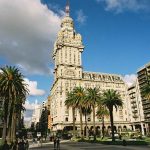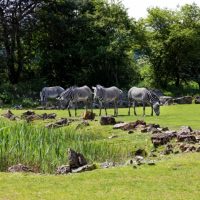Uruguay is a stunning country on the east coast of South America, and visiting its zoos and aquariums can be an experience unlike any other.
Therefore, for visitors seeking a unique opportunity to explore incredible wildlife, Uruguay’s zoos and aquariums can offer an unforgettable glimpse into the diverse fauna of this great nation.
From endangered species such as sea turtles to their majestic birds, there is something for everyone.
Contents
- Best Zoos & Aquariums in Uruguay
- 1. Acuario Aquarium in Colonia Del Sacramento
- 2. Bioparque Washington Rodriguez Piquinela Zoo
- 3. Parque Zoologico Francisco Lecocq
- 4. Zoologico Municipal de Villa Dolores
- 5. Colonia Del Sacramento Aquarium
- 6. Zoologico De Atlantida
- 7. The Zoologico de San Carlos
- 8. Zoo Villa Dolores
- 9. Refugio Ecológico Mi Zoo S C
- 10. Acuario Los Locos Aquarium
- 11. Acuario Azul Aquarium
- 11 Best Zoos & Aquariums in Uruguay – Summary Table
- Uruguay Safety Overview
- Frequently Asked Questions
Best Zoos & Aquariums in Uruguay
1. Acuario Aquarium in Colonia Del Sacramento
If you’re visiting Uruguay, one of the best things you can do is visit the Aquarium Colonia Del Sacramento.
The Aquarium Colonia Del Sacramento is located on the Rio de la Plata banks, which offers excellent city views.
Moreover, this specific aquarium is home to native Uruguayan fish, displayed to the public in various ways.
During your visit, you can challenge yourself to learn more about the region through a series of interactive displays and then test your newly gained knowledge through a series of quizzes.
2. Bioparque Washington Rodriguez Piquinela Zoo
The Bioparque Washington Rodriguez Piquinela is a zoo that is located in the Central Interior of Uruguay.
There are plenty of activities to engage in at the Bioparque Washington Rodriguez Piquinela.
Some of the highlights include:
- A tour of the zoo’s newest additions
- A photo op with the resident tiger
- A peek at the latest cubs to be born
Furthermore, this well-designed facility houses a collection of animals from Africa and Asia, including cheetahs, African wild dogs, and spotted hyenas.
Also, while on the subject of exotic animals, visitors can get up close and personal with a slew of nocturnal mammals, including Mexican gray wolves, which are on the endangered species list.
3. Parque Zoologico Francisco Lecocq
Parque Zoologico Francisco Lecocq is an animal and plant park near Montevideo, Uruguay, with 296 acres of natural open space to roam.
In fact, the Parque Zoologico Francisco Lecocq is one of the few in South America where visitors can observe native animals and plants in a safe and controlled environment.
Some of the more fascinating animals in the park include the red panda, the tiger, the lion, the bear, and the giraffe.
All in all, Parque Zoologico Francisco Lecocq is fun for visitors and a great way to educate them on the history of Uruguay, the region’s wildlife, and other exciting topics.
Additionally, this is one of the best places to see some of the more exotic species of Uruguay.
4. Zoologico Municipal de Villa Dolores
The Zoologico Municipal de Villa Dolores in Montevideo is home to 650 trees, 550 animals, and various South American animals.
Interestingly enough, the Zoologico Municipal de Villa Dolores sits on the site of a former military base, whose residents include some of the country’s most famous writers and artists.
However, what makes Zoologico Municipal de Villa Dolores genuinely unique is that visitors can get up close and touch these animals.
In addition, to affording visitors the ability to touch its animals, Zoologico Municipal de Villa Dolores has a tiger habitat that the London Zoo renovated.
Nevertheless, while the Zoologico Municipal de Villa Dolores is a relatively small place, it is doing its part to conserve the ecosystem by attempting to transform itself into an animal conservation society.
5. Colonia Del Sacramento Aquarium
The Colonia del Sacramento Aquarium, located in Colonia Del Sacramento, Uruguay, has a range of both marine and freshwater fish.
Additionally, the Colonia del Sacramento Aquarium offers an interactive center where visitors can ask questions, play games, and learn about the aquatic life of Uruguay.
In fact, several species that you will find at Colonia del Sacramento Aquarium can be found nowhere else but in Uruguay.
Among these exclusive species is the Odontesthes Argentines (odd-tailed catfish) which have been found in Uruguay’s rivers and are considered marine or estuarine.
Likewise, the Asian golden mussel populates the local waterways.
However, the Asian golden mussel is an invasive species that can be harmful to local wildlife.
Irrespective of the potential harms, fish, and mussel interactions are still understudied at Colonia Del Sacramento to determine their role in the ecosystem.
Last but certainly not least, the Rio de la Plata boat tour is the most impressive of the aquarium’s offerings.
These tours run every 30 minutes and provide tourists with a unique perspective on the flora and fauna of the river.
6. Zoologico De Atlantida
If you’re planning a trip to Uruguay, then you’ll want to check out the Zoologico de Atlantida.
The Zoologico de Atlantida is one of the most visited attractions in the country, and it is a must-see for anyone who learns of its existence.
While there are many zoos in Uruguay, the Zoologico de Atlantida is the one to visit if you are looking for a hefty dose of the South American country’s wildlife.
Specifically, this zoo has been around for some time but went through a restructuring to focus on smaller South American animals rather than the big cats of the past.
It is no surprise that the Zoologico de Atlantida zoo is a popular tourist destination for US and UK visitors.
7. The Zoologico de San Carlos
The Zoologico de San Carlos in the town of Maldonado is one of the oldest zoos in South America.
Visitors can see more than 3,200 animals and learn about their habitats.
Established in 1956, it has an extensive collection of animals, including 62 species of birds, fish, turtles, parrots, and deer. They also have an animal rescue center.
Several reasons make the Zoologico de San Carlos unique:
- It sits in a native forest.
- The zoo breeds its animals on natural pastures and water streams.
- It has an incubation room to ensure that animals can reproduce.
Other features include a playground and an aquarium.
Moreover, visitors can go on guided tours to learn even more about the Zoologico de San Carlos.
8. Zoo Villa Dolores
The Zoo Villa Dolores is a tremendous zoological center.
It is the largest zoological center in South America.
For starters, Zoo Villa Dolores is a unique and exciting zoo with plenty of attractions to enchant visitors of all ages.
Here, you can see all kinds of animals, including polar bears, zebras, dolphins, elephants, lions, rhinos, and even birds.
In fact, there are five hundred fifty animals living at Zoo Villa Dolores that come from all over the world.
What is equally as impressive is that visitors can see the animals up close and even touch them.
Nevertheless, one of the newest attractions at the zoo is an oceanarium that focuses heavily on environmental threats.
Thus, as part of the zoo’s program to raise awareness about environmental issues, the oceanarium features a wildlife rescue center.
9. Refugio Ecológico Mi Zoo S C
Located on a small island in the Uruguay River, a Rio de la Plata tributary, the Refugio Ecológico MI ZOO S C Rivera, Uruguay, is a non-profit organization.
The Refugio is home to an extensive collection of exotic animals.
Most of the species here are native to Uruguay and include armadillos, jaguars, deer, wildcats, foxes, and several types of rodents.
Other wildlife, such as pumas, can be found in remote areas.
In addition, some venomous snakes have a habitat in some parts of the country.
The surrounding landscape is characterized by gently rolling sand-covered land with broad valleys and ridges.
Trees and other plant species, such as alder, pine, eucalyptus, and willow, are also common.
Unfortunately, while there is no official website, visitors can check out the group’s Facebook page to gain a better understanding of what Refugio Ecológico MI ZOO S C has to offer.
10. Acuario Los Locos Aquarium
The Acuario Los Locos aquarium is a beautiful place for the entire family to visit in Montevideo, Uruguay.
It is a unique aquarium with exceptional aquatic life that only Uruguay can offer.
From pythons to whale sharks, the Acuario Los Locos aquarium houses several animals that would make any animal lover’s eyes light up.
In addition to the creatures native to the country, some other exotic species from around the globe are present.
These exotic species include the southern lapwing, which is the only crested wader in South America and is Uruguay’s national animal.
The aquarium also features a giant squid mold and the skeletons of other sea creatures.
11. Acuario Azul Aquarium
Uruguay’s Acuario Azul Aquarium is worth a visit if you are interested in seeing some stunning fish and other local fauna.
Stingrays, sea lions, eels, and even seahorses are some of the amazing sea creatures that call the Acuario Azul Aquarium home.
In fact, the Acuario Azul Aquarium houses an impressive fifty-two tanks of sea life, including the world’s biggest tadpole.
However, one of the more impressive features of the Acuario Azul is its state-of-the-art Oceanic Fish Tank.
What makes the Oceanic Fish Tank so impressive is that it is filled with over 420,000 gallons (1,589,873 liters) of seawater.
In addition to the amazing displays that the Acuario Azul Aquarium provides, admission is free.
With free admission, the Acuario Azul Aquarium is the ideal spot for a school field trip or a family outing.
11 Best Zoos & Aquariums in Uruguay – Summary Table
| Zoos & Aquariums | Address |
|---|---|
| Acuario Aquarium in Colonia Del Sacramento | Virrey Ceballos, 70000 Col Del Sacramento, Departamento de Colonia, Uruguay |
| Bioparque Washington Rodriguez Piquinela Zoo | Ruta 5 Brigadier General Fructuoso Rivera, |
| Parque Zoologico Francisco Lecocq | 6M49+55J, Luis B. Berres, Montevideo, Montevideo Department 12600, UY. |
| Zoologico Municipal de Villa Dolores | 3VX3+JWR, 11600 Montevideo, Departamento de Montevideo, Uruguay |
| Colonia Del Sacramento Aquarium | Virrey Ceballos, 70000 Col Del Sacramento, Departamento de Colonia, Uruguay |
| Zoologico De Atlantida | 66FW+HV8, 15200 Atlántida, Departamento de Canelones, Uruguay |
| The Zoologico de San Carlos | Joaquin Suarez 655, 20400 San Carlos, Departamento de Maldonado, Uruguay |
| Zoo Villa Dolores | 3VX3+JWR, 11600 Montevideo, Departamento de Montevideo, Uruguay |
| Refugio Ecológico Mi Zoo S C | Sergio Martínez Camargo 2663, 40000 Rivera, Departamento de Rivera, Uruguay |
| Acuario Los Locos Aquarium | Andrés Spikerman 3723, 12000 Montevideo, Departamento de Montevideo, Uruguay |
| Acuario Azul Aquarium | Suarez watsap 091666242, 15600 Pando, Departamento de Canelones, Uruguay |
Uruguay Safety Overview
READ THE FULL REPORT: Uruguay Safety Review
Safety Index:
- OVERALL RISK: LOW
- TRANSPORT & TAXIS RISK: LOW
- PICKPOCKETS RISK: MEDIUM
- NATURAL DISASTERS RISK: MEDIUM
- MUGGING RISK: MEDIUM
- TERRORISM RISK: LOW
- SCAMS RISK: MEDIUM
- WOMEN TRAVELERS RISK: LOW
Frequently Asked Questions
What is the best time of year to visit Uruguay?
Generally speaking, visiting Uruguay in the fall and spring is best.
Specifically, these seasons are the most pleasant weatherwise, and you’ll enjoy fewer crowds.
What is the currency in Uruguay?
The Uruguayan Peso (UYU) is the official currency of Uruguay.
How can I get around in Uruguay?
The best way to get around is by bus, as buses are very reliable, inexpensive, and comfortable.
Additionally, multiple bus lines run throughout Uruguay.
What is the climate like in Uruguay based on the time of year?
Winters can be chilly and damp.
Conversely, summers are typically hot and sunny.
During summer, thunderstorms occur more frequently than in the winter.
Nevertheless, Montevideo, Uruguay, experiences rainfall throughout the year and gets foggy at times.
Montevideo’s average annual temperature is approximately 16.3 degrees Celsius (61.3 degrees Fahrenheit).
However, during a heat wave, temperatures can climb as high as 38 to 40 degrees Celsius (100 or 104 degrees Fahrenheit).











